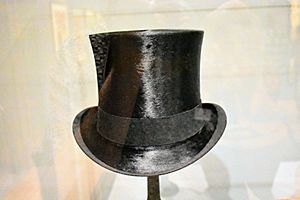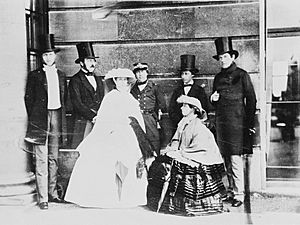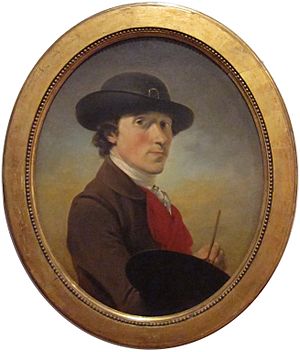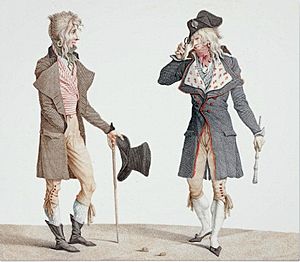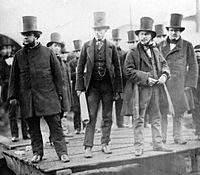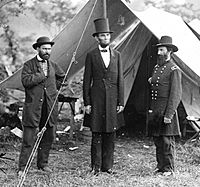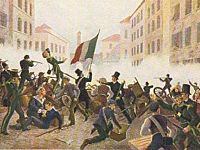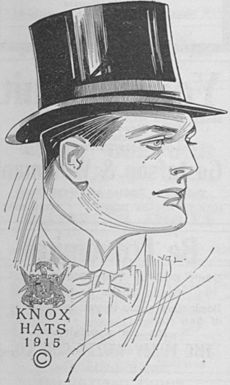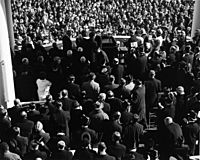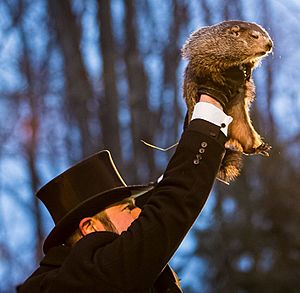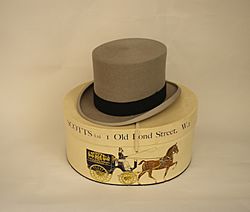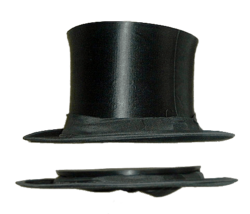Top hat facts for kids
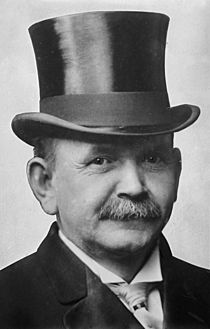
A top hat is a tall hat with a flat top. People also call it a high hat, a cylinder hat, or a topper. For a long time, it was worn with very formal clothes in Western countries. This included outfits like white tie (the most formal evening wear), morning dress (formal daytime wear), or a frock coat (a formal coat).
Top hats are usually black and made of silk, but sometimes they are grey. They first became popular in the late 1700s. Even though they were worn less often after the 1960s, they are still a formal fashion accessory today. There's also a special type of top hat that can fold flat, called an opera hat. This was invented in the 1800s.
The idea for the top hat might have come from older hats called capotains. Around the 1770s, taller hats with wide brims became popular for country outings. By the 1780s, the top hat started to replace older hats like the tricorne and bicorne hats. By the 1790s, people in cities all over the Western world, especially the upper and middle classes, wore top hats with their formal coats.
At first, hats made from beaver fur were popular. But around the 1800s, black silk became the main material. In the 1840s, the frock coat became popular for formal daytime wear, and people wore top hats with them. Top hats were also worn with formal evening wear, known as white tie. Later in the 1800s, morning dress started to replace frock coats, and top hats were worn with morning dress too.
After World War I, in the 1920s, less formal clothes like black tie (semi-formal) and everyday suits became common. People started wearing different hats like bowler hats, homburg hats, boater hats, and fedoras. After World War II, top hats and the very formal clothes they went with became mostly limited to high society, politics, and international meetings.
The last time a top hat was worn at a United States presidential inauguration was in 1961, when John F. Kennedy became president. After the 1960s, fewer and fewer men wore hats every day, and the use of top hats declined even more.
Still, top hats are worn for very formal events today. These include weddings, funerals, certain parties, and horse racing events like Royal Ascot and the Epsom Derby. They are also part of the formal uniform for people in important roles in some British groups, like the Bank of England and some officials in the City of London. Judges, choirboys, dressage horseback riders, and doormen also sometimes wear them.
In popular culture, the top hat is often linked to rich people. Cartoonists sometimes use it to represent capitalism or business, like with the Monopoly Man or Scrooge McDuck. The top hat is also part of the traditional look of Uncle Sam, a symbol of the United States, usually with red, white, and blue stripes. Since the famous "Pulling a Rabbit out of a Hat" trick by Louis Comte in 1814, the top hat has also been a symbol of stage magic and hat tricks.
Contents
What's in a Name?
The top hat has a few other names! Sometimes it's called a beaver hat or silk hat because of what it's made from. People also informally call it a chimney pot hat or stove pipe hat because of its tall, straight shape.
The Story of the Top Hat
Fashion experts believe the top hat might have come from the sugarloaf hat. It's hard to say exactly who invented it. Gentlemen started wearing top hats instead of tricorne hats in the late 1700s. A painting from 1796 by Charles Vernet, called Un Incroyable, shows a French dandy (a very fashionable man) wearing one. The first silk top hat in England is thought to have been made by George Dunnage, a hat maker from Middlesex, in 1793. Many people wrongly think a hat seller named John Hetherington invented it.
Within 30 years, top hats were popular with everyone, even workers. At that time, hats worn by richer people were usually made of felted beaver fur. Hats made from other felt materials were called "stuff hats." Top hats even became part of the uniforms for police officers and postmen, to make them look important. Since these workers were outside a lot, their hats were covered with black oilcloth to protect them.
Top Hats in the 1800s
Between the late 1700s and early 1800s, silk "hatter's plush" slowly replaced felted beaver fur. However, some people still preferred beaver hats.
In the 1840s and 1850s, top hats became very tall with narrow brims. The stovepipe hat had mostly straight sides, while the "chimney pot" hat had slightly curved sides. Abraham Lincoln made the "stovepipe" style famous in the United States during his time as president. He often carried papers and letters inside his hat! One of Lincoln's top hats is on display at the National Museum of American History in Washington, D.C.
-
Isambard Kingdom Brunel and others at the launch of the SS Great Eastern ship in London, 1857.
-
Abraham Lincoln (in the middle) wearing his famous "stovepipe" silk hat in 1862.
During the 1800s, the top hat became a symbol of being a respected person in the city. When Prince Albert started wearing them in 1850, their popularity grew even more. The rise of silk plush top hats might have led to fewer beaver hats being made, which reduced the beaver trapping business in North America.
The writer James Laver once said that a group of "toppers" looked like factory chimneys, adding to the feeling of the industrial age. In England, fashionable men after Beau Brummel wore hats with flared tops and sweeping brims. In France, similar fashionable men called "Incroyables" wore such huge top hats that they couldn't fit them in coatrooms until the folding top hat was invented.
Top Hats in the 1900s
Until World War I, the top hat was a standard part of formal outdoor wear for upper-class men, both during the day and in the evening. However, because they were expensive and not always convenient, softer hats became more common for everyday wear. By the end of World War II, top hats were quite rare, though they were still worn for certain special roles. For example, some officials in the Bank of England and stockbrokers in the City of London wore them.
Top hats were also worn in politics and international meetings for many years. For example, the Japanese officials who signed the end of World War II in 1945 all wore top hats. For a long time, U.S. presidents wore top hats for their inaugurations. President Dwight D. Eisenhower didn't wear one, but John F. Kennedy brought it back for his inauguration in 1961. However, Kennedy gave his speech without a hat, showing a more active image. His successor, Lyndon B. Johnson, didn't wear a top hat for his inauguration in 1965, and no president has worn one since for this event.
In the British House of Commons, there used to be a rule that if a Member of Parliament wanted to speak during a vote, they had to sit down and wear a top hat. This rule was removed in 1998 because it made the House look silly.
Even though Eton College no longer uses the top hat as part of its uniform, "Monitors" at Harrow School still wear them with their Sunday uniform. Male members of the British Royal Family also wear top hats for State occasions, like the Diamond Jubilee in 2012. Top hats are also worn at some horse racing events, especially The Derby and Royal Ascot. They are also worn at the Tynwald Day ceremony and other formal events on the Isle of Man.
In George Orwell's book Nineteen Eighty Four, the top hat is used in the government's propaganda. It says: "These rich men were called capitalists. They were fat, ugly men with wicked faces [...] dressed in a long black coat which was called a frock coat, and a queer, shiny hat shaped like a stovepipe, which was called a top hat. This was the uniform of the capitalists, and no one else was allowed to wear it."
-
Winston Churchill in a frock coat with a grey top hat.
-
The inauguration of John F. Kennedy in 1961. Many men have their hats off, but some top hats can still be seen.
Top Hats Today
The most common top hat today is a hard, black silk hat, often made of fur. The colors are still mostly black or "white" (which is actually grey). Grey hats are worn for less formal events that still require a top hat, like Royal Ascot, or with a morning suit. In the U.S., top hats are often worn in horse driving sports and for formal fox hunting.
The folding silk opera hat, also called a crush hat, is still worn sometimes. It's black if worn with evening wear as part of white tie. A few companies still make them using traditional materials like satin or grosgrain silk.
In formal academic dress, the Finnish and Swedish doctoral hat is a type of top hat that is still used today.
Some famous musicians have worn top hats. American rock musician Tom Petty often wore different types of top hats. The British-American musician Slash has worn a top hat since he was in Guns N' Roses, and it's become a famous part of his look. Panic! at the Disco's Brendon Urie also wears top hats often in his performances and music videos.
The members of the "Inner Circle" of the Punxsutawney, Pennsylvania Groundhog Club wear top hats every February 2nd when they do the Groundhog Day ceremonies with Punxsutawney Phil.
The Steampunk culture also includes top hats as a popular headgear choice. These steampunk top hats are sometimes made of leather and might have fake gears or other decorations on them.
A top hat, often red, white, and blue, or with stars and stripes like the American flag, is part of the usual costume for Uncle Sam, a symbol of the United States.
For people who draw cartoons or make fun of politics, the top hat was an easy way to show the upper class, business, and capitalism. A character wearing a top hat would instantly be seen as a rich and powerful person. The character Rich Uncle Pennybags in the board game Monopoly wears a top hat. Also, a top hat is one of the game pieces players use to move around the board.
Top Hats in Freemasonry
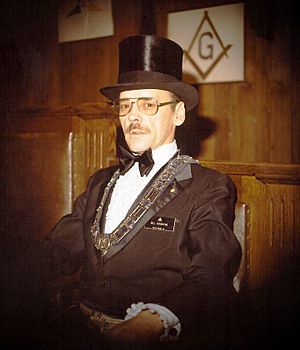
In Freemasonry, especially in North American lodges, top hats are often linked to the leader, called the Worshipful Master. He is the only person allowed to wear a hat inside the lodge to show his leadership. However, he doesn't have to wear a top hat; he can wear any hat he thinks is right for the occasion, as some lodges are more formal than others. It's also common for a Worshipful Master to get gifts related to top hats when he starts his role or when he finishes. In some other countries, like Germany, all members of the lodge wear top hats.
Top Hats in Judaism
In some synagogues, the president and other important officers might wear a top hat on Shabbat (the Sabbath) or during major festivals. This custom of wearing a top hat, or tzylinder in Yiddish, started in England in the 1800s. It replaced older head coverings like wigs and tricorn hats. This custom became common in Europe until The Holocaust. In some traditional Sephardi synagogues, members of the congregation might also wear top hats for special events.
What a Top Hat Looks Like
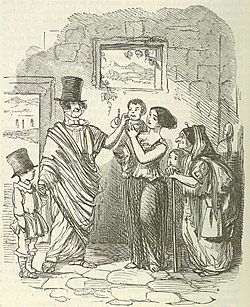
A silk top hat is made from a special material called hatters' plush. This is a soft silk fabric with a very long, soft surface. This material is rare now because it hasn't been made much since the 1950s. It's believed that the machines needed to make it no longer exist. Today, top hats are usually covered with fur plush or a material called melusine. A popular choice is also a grey flat fur felt top hat.
You might also see top hats made from stiff or soft wool felt. However, these are not considered as fancy as the silk, fur plush, or grey felt hats. The most common shape for the top of the hat today is the 'semi-bell crown', which is slightly curved. 'Full bell crowns' (more curved) and 'stovepipe' (very straight) shaped hats are less common.
Because old silk hats are rare and new ones are expensive, vintage (old) top hats are very popular. It can be hard to find them in good condition. The price often depends on the size (larger sizes are usually more expensive) and how good the condition is.
How Top Hats Are Made
In the past, top hats were made by shaping a single piece of wool or fur felt and then covering it with fur plush. After silk plush was invented, a new method using gossamer was created and used for a long time.
A formal silk top hat is made by first shaping two pieces of gossamer (a special fabric coated with a shellac solution) over a wooden hat block. This forms the main shell of the hat. After the shell dries, the brim (made of several layers of gossamer for strength) is attached. The whole shell is then coated with a special varnish and left to dry again.
Next, the silk plush is carefully cut and sewn together. It's then gently placed over the shell and ironed. The heat from the iron melts the shellac, making the plush stick to the hat. The top of the brim is also covered with silk plush or a ribbed silk. The underside of the brim is covered with merino cloth. After the hat has fully dried, the brim is curled and finished with a silk ribbon. Finally, the lining and a leather sweatband are carefully sewn in by hand.
Some top hats, called "country-weight," were made with more layers of gossamer to make them stronger for riding and hunting.
Opera Hat
On May 5, 1812, a hat maker in London named Thomas Francis Dollman got a patent for an "elastic round hat." This hat had ribs and springs to keep its shape. His patent described a hat that could be made of beaver, silk, or other materials. The top and bottom parts were stiff, but the rest of the hat was soft and kept its shape with horizontal ribs and elastic steel springs inside. When packed for travel, a ribbon could be pulled over the top to keep it flat.
Some people think this was an early folding top hat. In France, around 1840, Antoine Gibus created a very popular folding top hat with springs. These hats became known as gibus hats. They were also often called opera hats because people would flatten them and store them under their seats at the opera. The snapping sound the hat made when it opened gave it another name: the chapeau claque, from the French word claque, meaning "slap."
Images for kids
-
Ants Piip, the first leader of Estonia, wearing a top hat in 1923.
-
Mustafa Kemal Atatürk wearing a top hat and white tie in 1925.
-
Brazilian President Washington Luís wearing morning dress and a top hat during a military ceremony in the late 1920s or early 1930s.
-
Contemporary hip-hop musician T-Pain wearing a blue-and-white striped top hat at the Video Music Awards in 2008.
-
A stage magician using a top hat as a prop.
See Also
- Gat (hat)
- List of headgear
- Shako, a tall, cylindrical military cap


